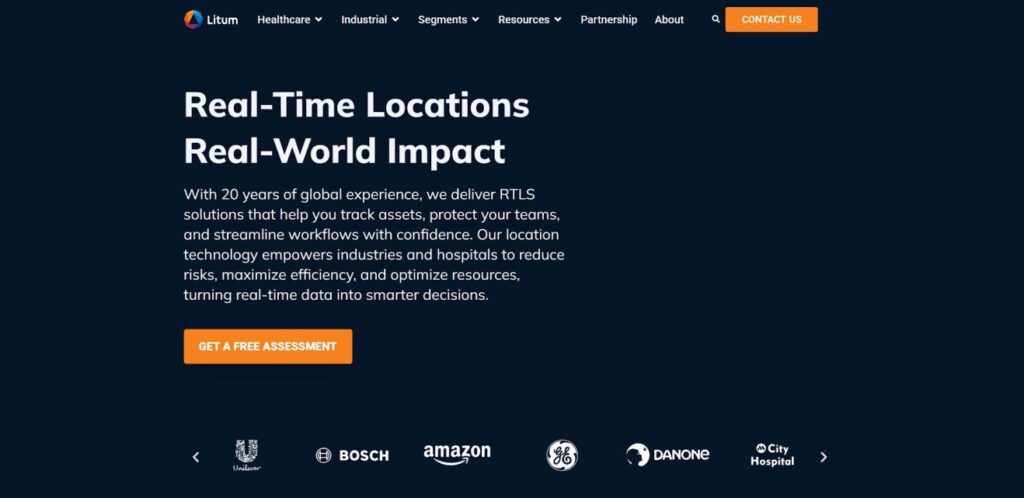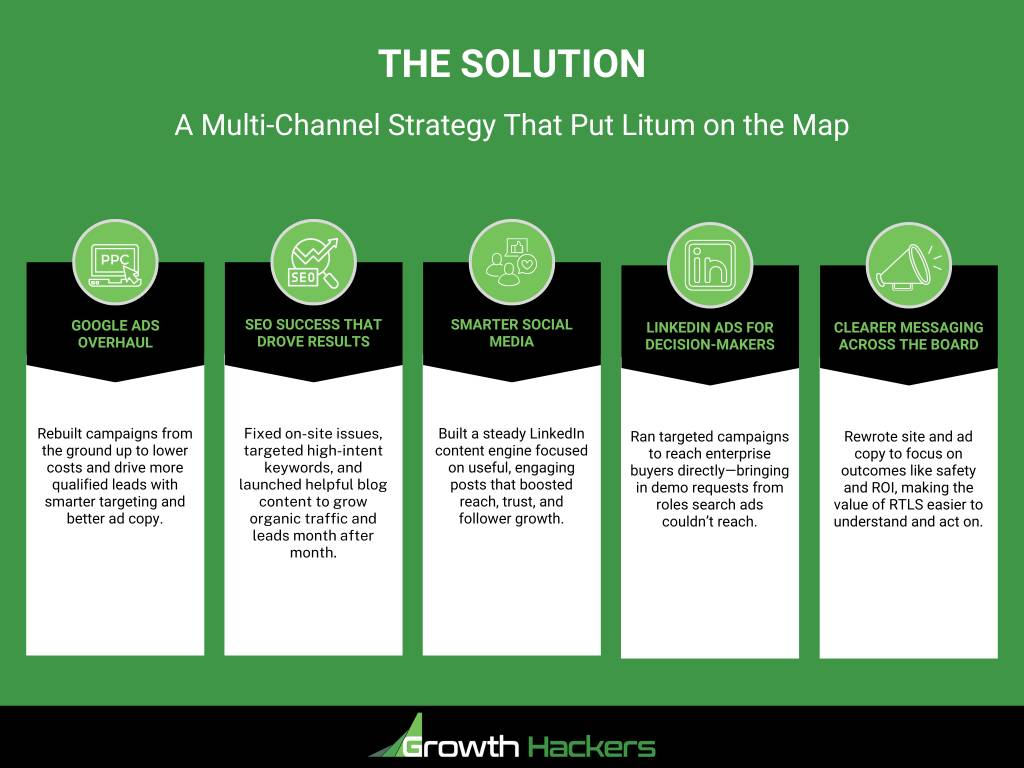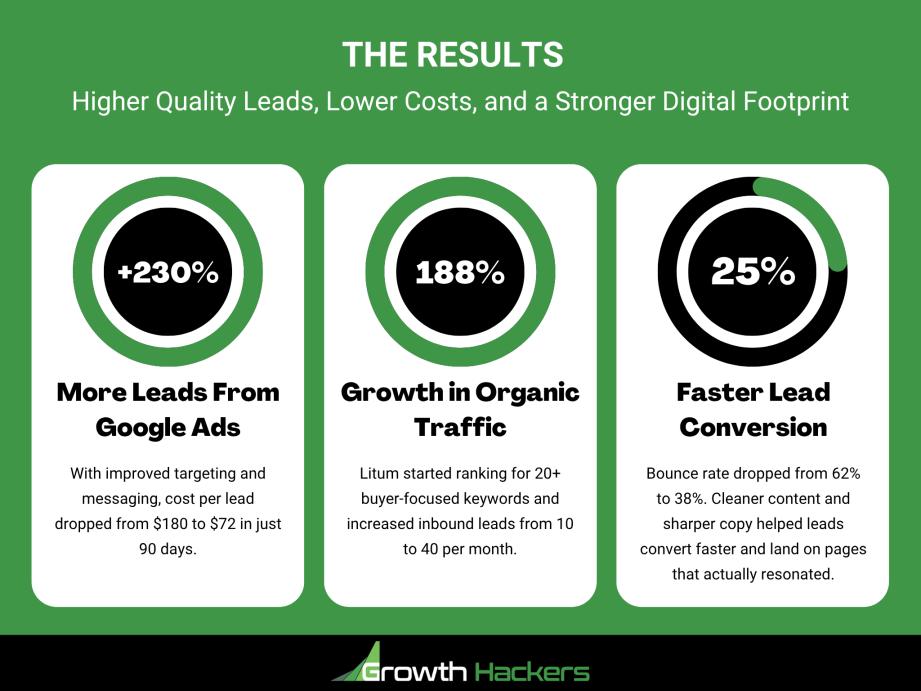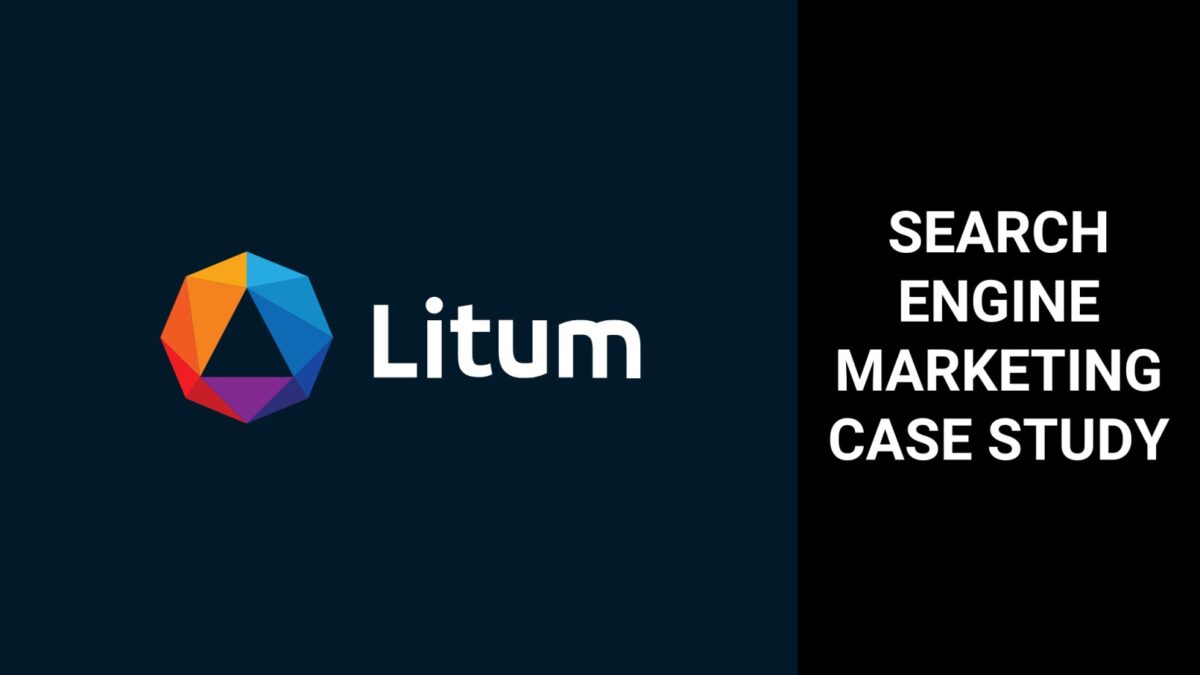When Litum, a global leader in real-time location systems (RTLS), came to us, they already had an impressive track record—serving industries like healthcare, manufacturing, and logistics with precision tracking solutions. But even with a strong product and a list of Fortune 500 clients, their digital marketing was falling short. Their paid ads weren’t performing, organic visibility was limited, and social engagement was almost non-existent.
They knew they had a powerful story. They just don’t have the right strategy to target the audience effectively. That’s where we came in. Our goal was simple: help Litum break through the noise, reach the right decision-makers, and generate leads that actually turned into sales. Here’s how it all unfolded.

Company Overview
Initial Vision and Product
Litum was founded with a straightforward goal: to improve safety and efficiency in complex environments through real-time location technology. With roots in engineering and a strong focus on research and development, the company began by building RTLS (Real-Time Location Systems) to help businesses track assets, monitor workers, and streamline operations. From factories to hospitals, Litum’s early products were designed to give organizations better visibility into what’s happening on the ground, in real-time.
Success and Growing Pains
Over two decades, Litum built a global presence, working with Fortune 500 companies and deploying solutions across more than 50 countries. Their systems became known for their accuracy, reliability, and ability to reduce costs and risks in both industrial and healthcare settings.
But as the company grew, new hurdles started to appear. The demand for digital visibility increased, and Litum found itself needing a stronger voice online. While the technology was proven, the brand’s online visibility—through search engines and social media—lagged behind, limiting the flow of new leads and slowing broader market recognition.
The Turning Point
With more competition entering the market and more buyers starting their search online, Litum recognized that having top-tier technology wasn’t enough—they needed to show up where prospects were already looking. That realization pushed the team to rethink their marketing approach. It was time to improve their presence across search engines and social platforms and bring in expert support to do it right.
The Challenge: A Powerful Product with Low Digital Visibility
Litum had cutting-edge RTLS tech and a solid client base—but online, they were nearly invisible. Their website wasn’t showing up on Google for key industry searches, and their paid ads were underperforming. They had social media accounts but weren’t using them to connect with decision-makers in manufacturing, healthcare, or logistics.
Here’s what wasn’t working:
- Poor Search Engine Rankings – Their competitors dominated search results for key terms like “forklift safety” and “connected worker,” while Litum’s site lagged behind. Basic SEO elements were missing or outdated.
- Weak Google Ads ROI – Their paid search efforts were unfocused, with low conversion rates, unclear targeting, and no reliable tracking to measure success.
- Inactive Social Channels – LinkedIn and other platforms weren’t being used to engage their B2B audience. Posts were sporadic and didn’t drive interaction.
- No LinkedIn Ads – Despite being in a B2B space, Litum hadn’t tapped into LinkedIn’s targeting capabilities, missing the chance to reach key decision-makers.
- Content Misalignment – Their messaging focused too much on technical specs and not enough on the business outcomes buyers care about—like ROI or safety improvements.
Litum had the product. They just weren’t showing up where it mattered. That’s where we stepped in.
Ready to uncover winning tactics through our search engine marketing case study?
Contact Growth Hackers

The Solution: A Multi-Channel Strategy That Put Litum on the Map
To fix the website’s visibility, Growth Hackers launched a full-funnel digital marketing strategy covering SEO, Google Ads, social media, and LinkedIn advertising. The goal was to increase quality traffic, improve lead generation, and give the brand a voice that resonated with real decision-makers.
Here’s how we tackled it:
1. Google Ads Overhaul
We rebuilt Litum’s Google Ads account from scratch—grouping campaigns by product and industry, rewriting ads to focus on ROI and safety outcomes, adding negative keywords, and setting up proper conversion tracking. A/B testing helped refine everything from headlines to landing pages. The result: better-qualified traffic, lower CPC, and more leads.
2. SEO Success That Drove Results
We researched high-intent keywords, fixed on-page issues, improved site speed, and rolled out a new blog plan based on what prospects were actually searching. Posts like “How RTLS prevents forklift accidents” positioned Litum as a helpful resource. We also built backlinks through targeted outreach to strengthen domain authority.
3. Smarter Social Media
We created a consistent posting schedule focused on engaging, value-driven content—client wins, tips, visuals, and short videos. LinkedIn became a core focus, with tailored posts and interaction in relevant communities. This boosted reach, credibility, and follower growth.
4. LinkedIn Ads for Decision-Makers
We launched highly targeted LinkedIn Ads aimed at operations leaders, safety managers, and hospital administrators. Sponsored InMail, feed ads, and lead forms were used to drive demo requests directly on the platform—capturing enterprise leads that search alone couldn’t reach.
5. Clearer Messaging Across the Board
We helped Litum shift from technical jargon to benefit-driven copy. Website and ad content were rewritten to highlight ROI, compliance, and safety impact—making the value of RTLS easier to grasp for non-engineers.
Together, these changes gave Litum a much stronger digital presence and helped them connect with high-value leads, as shown in our case studies, in a way that finally matched the quality of their product.

The Results: Higher Quality Leads, Lower Costs, and a Stronger Digital Footprint
After implementing Growth Hackers’ multi-channel strategy, Litum saw measurable improvements across every major marketing KPI—ads, search, social, and conversions. What had been a scattered and underperforming digital presence was now a focused growth engine bringing in leads from several reliable sources. The results came in fast and held steady over time.
1. PPC That Finally Performed
In just the first 90 days, after conducting thorough keyword research the overhauled Google Ads campaigns showed a clear turnaround:
- Lead volume increased by 230%, with a steady monthly average of 100+ qualified leads from search alone.
- Cost per lead (CPL) dropped from $180 to $72, thanks to improved keyword targeting, better ad copy, and negative keyword filters.
- The click-through rate (CTR) rose from 1.2% to 4.6%, showing that the new messaging resonated more with users.
- Conversion rate on the landing page increased from 1.9% to 6.3%, driven by a better layout, sharper copy, and fewer friction points.
These changes helped Litum stretch its ad budget further while reaching more of the right people.
2. SEO Growth That Compounded Monthly
Organic traffic became one of Litum’s most reliable lead sources, thanks to the SEO strategy we put in place:
- Monthly organic search traffic increased by 188% over six months, driven by both new blog content and on-page optimizations.
- Litum ranked on page 1 of Google for 20+ high-intent keywords, such as “worker safety RTLS”, “RTLS safety”, and “RTLS manufacturing.”
- Average time on the page rose to 2 minutes 43 seconds, showing stronger content engagement and lower bounce rates.
- Organic leads went from 10 per month to 35–40, many from industries Litum was trying to grow into (e.g., logistics, mining, and healthcare).
This gave Litum a long-term, compounding channel for lead generation—without needing to pay for every click.
3. LinkedIn Ads Opened the Door to Enterprise Accounts
LinkedIn ads added a new layer of high-value lead acquisition, especially among enterprise buyers:
- Click-through rates reached 0.7%, which is above average for LinkedIn in B2B (0.4–0.6% is typical).
- Cost per lead averaged $120, well within range for enterprise targeting.
- Generated over 90 qualified leads in the first 3 months, many from titles like Operations Director, Safety Manager, and Plant Supervisor.
- Three enterprise deals originated from LinkedIn ad touchpoints, helping Litum crack into new verticals like food processing and pharmaceuticals.
While LinkedIn was a more expensive platform, the quality of leads justified the spend.
4. Social Media That Actually Got Noticed
Growth Hackers also turned Litum’s dormant LinkedIn company page into a growing content strategy hub:
- Follower count grew by 77% over six months (from 3,840 to 6,800).
- Average post impressions rose from 500 to 3,400, driven by smarter content and consistent posting.
- Engagement rates more than doubled, especially on posts that highlighted customer success stories and industry data.
This gave Litum more credibility with both prospects and partners, and it made cold outreach feel warmer.
5. Stronger Messaging, Better Conversions
By sharpening its messaging across ads, landing pages, and social, Litum saw:
- Shorter sales cycles, with inbound leads converting to qualified opportunities 25% faster.
- Lower bounce rates on key product pages (from 62% to 38%) thanks to clearer headlines and more focused content.
- Improved sales alignment, since the leads coming in already understood the value of RTLS—and didn’t need as much upfront education.
In short, Growth Hackers helped Litum do more than just generate traffic—they helped turn digital channels into real growth channels. With better targeting, clearer messaging, and smarter use of ad dollars, Litum went from scattered marketing to a reliable, scalable engine for sales.
Implement what works—straight from our search engine marketing success story.
Work with Growth Hackers
Lessons Learned: What Helped Litum Break Through (and What Others Can Learn Too)
Litum’s journey from scattered efforts to solid digital performance came with a few hard-won lessons, as illustrated in our SEO case studies —ones that other B2B tech companies can take to heart.
1. More Traffic Means Nothing Without the Right Strategy
Before working with Growth Hackers, Litum had traffic… but most of it wasn’t converting. Their old campaigns brought in the wrong visitors or wasted budget on low-intent keywords. The fix wasn’t just “more leads,” but better-qualified ones. It took focused messaging, audience research, and smarter targeting to get there. The lesson: raw traffic is easy to buy—but results come from strategy.
2. You Can’t Just “Set and Forget” Paid Ads
Litum’s early PPC setup had been running with barely any updates for months. Once Growth Hackers stepped in and started testing headlines, adjusting bids, and using negative keywords, performance improved fast. Regular upkeep and testing were key. The takeaway? Paid ads work—if you treat them like a living thing, not a checkbox.
3. SEO Takes Time… But It Pays Off
At first, investing in blog content and technical SEO felt like a long game. But by month 4, thanks to effective search engine optimization organic traffic was steadily climbing, and the leads it brought in were some of the most sales-ready. Even old posts continued pulling traffic thanks to smart keyword choices and internal linking. Lesson learned: SEO may take longer, but it builds momentum that keeps paying off.
4. LinkedIn Isn’t Just for Posting—It’s a Lead Source
Before Growth Hackers, Litum’s LinkedIn presence was mostly passive. But paid LinkedIn ads, paired with better company page content, helped attract decision-makers that other channels missed. The surprise wasn’t just in the lead volume—but in the quality. The lesson: LinkedIn is worth the investment if you know who you’re targeting.
5. Good Messaging Speeds Up the Whole Funnel
One unexpected win was how much better messaging helped the sales team. When leads came in with a clear understanding of what Litum offered—and why it mattered—they moved faster through the pipeline. Fewer calls were needed to “explain the basics.” That saved time and made sales conversations more productive.
In the end, the biggest lesson was this: strong digital marketing isn’t about chasing the latest trend—it’s about getting the fundamentals right and making them work together. Litum’s growth didn’t come from flashy tricks. It came from a steady, focused effort on doing the right things, in the right order.
Conclusion: Real Growth from a Real Strategy
Litum’s case proves that with the right digital strategy, even a niche B2B manufacturing company can unlock steady growth through search engines and social media. They didn’t rely on hype or short-term wins—instead, they focused on high-impact tactics like paid search, SEO, and LinkedIn ads that brought in leads with real purchase intent. With every channel working in sync, they reached the kind of visibility and lead quality they had been missing for years.
This wasn’t about doing everything—it was about doing the right things in the right way. From rethinking their messaging to improving targeting and content, the shift was intentional and data-driven. In less than a year, Litum went from struggling to convert visitors into leads, to building a reliable flow of qualified interest that supports their long-term sales goals.
If you’re looking to turn your website, ads, and social channels into a real source of leads—just like Litum did—it’s time to talk.
Growth Hackers is a multi-awarded search engine marketing agency specializing in strategies that actually convert. I don’t just give advice—I work directly with you to build and execute a custom plan based on what works. Whether it’s dialing in your Google Ads, scaling SEO content that ranks, or using social platforms like LinkedIn to speak directly to decision-makers, I bring the tools and the team to help you grow faster, smarter, and higher.
Ready to leave guesswork behind and start growing like you mean it? Contact Growth Hackers and let’s make it happen.




